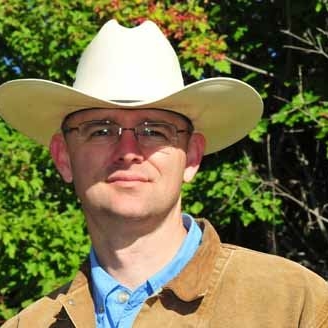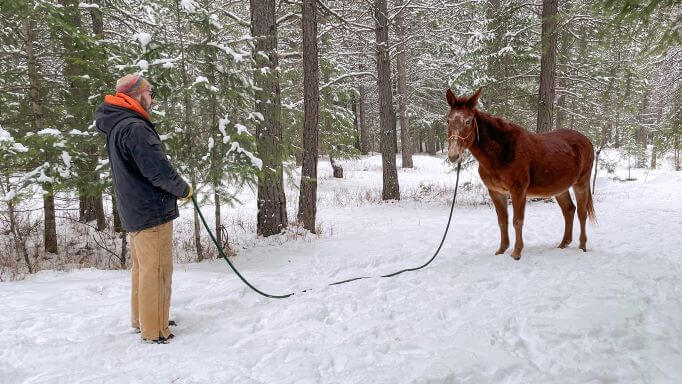I often park my animals without tying them. Asking them to stay in one place isn’t too much to ask, so it’s one of the first skills I train. Here’s how I teach my equines to “whoa” without being tied.
Standing Still
Whether it’s stepping away from your horse to grab something from the tack room or ground tying while clearing a branch from the trail, standing still makes for a good horse. My goal is to have my animals stand quietly untied while grooming, tacking up, or loading pack saddles. I feel that if my animals can stand calmly as I’m walking around the barn, they’ll be that much better at a trailhead with all sorts of activity and commotion around them. I want my animals focused on me, not whatever else is happening around them.
I begin with a simple exercise: I stand in front of my horse at the end of the lead rope, facing him. I let the body of the lead lay on the ground and say, “whoa”. Then I wait. Of course, there’s a little more to it than that. Here’s how I break it down.
I use a rope halter and long-ish lead. The rope halter provides targeted pressure that I can instantly release. A longer lead rope allows me to gradually increase my distance from the horse as we progress. I tie the lead to the halter when we’re learning instead of using a metal snap. I want the knot to annoy my horse but not hurt him.
Once you have your horse and equipment sorted, hold the lead in your hand and turn to face the horse. I like to stand as far away as I can, but in the beginning that may be only 4 or 5 feet. Now ask him to stand still with a “whoa.” The cues your horse will latch on to are your turning to face them and the verbal “whoa.” Facing the horse is my preparatory command and the verbal cue is the command of execution.
Once you’ve said “whoa,” wait. As soon as the horse moves a leg, shake the rope vigorously. This is the same signal for backing up. As soon as the horse is back in the original spot, stop and drop the lead so that the rope’s body is on the ground and lifeless.
Instant corrections and cessation of those corrections are paramount. The quicker you catch an attempt at movement, the better your horse will understand what he did wrong. The prompt release of pressure when he’s where he should be lets him know he did well. The amount of rope shaking required will become dramatically less over time as you and your horse work on this exercise. Eventually, you may merely have to pick up the lead or just give him a look, and any fidgeting will cease.
Building the Skill
Over time you’ll find that the horse will stand quietly for longer and longer without moving away. As you, and your horse, get better with this skill, you’ll notice that your horse is watching and focusing on you and won’t walk off until you give him the ok.
To build the wait duration, work for longer and longer periods of standing quietly. At first, it may only last for several seconds without a correction but aim longer on the next try. The beauty of these standing exercises is that you can do them practically anywhere.
Once your horse has developed the patience to stand quietly for a few minutes with you nearby, it’s time to increase the challenge by dropping the lead line. That’s right, let it go! Take a few steps away and see what happens. If he moves, a sharp “whoa” should stop him. If it doesn’t, just grab the lead and put him back in his original location. Repeat. Gradually build on this by walking further and staying away more extended periods. Congratulations, you’ve got a horse that ground ties.
Practice Makes Predictable
I practice these exercises constantly, both at home and on the trail. I feel that if my critters cannot stand still for grooming and saddling without being tied, then they’re not ready for more advanced endeavors such as trail riding. I count on my riding animal to stand quietly while I clear downfall or adjust a pack load on the trail. Yes, I’m taking a chance on a long walk, but I’ve developed confidence over many years with these critters. Building a horse that trusts you as his herd leader and does as you ask takes time and effort. There are no shortcuts.
For more on trail riding and camping with horses please visit www.trailmeister.com. Find more information in my Amazon best-selling book The ABCs of Trail Riding and Horse Camping – Essential Knowledge for Trail and Camp. You can purchase the book at https://amzn.to/3CuErid.
See this article in the January/February 2022 online edition:

Robert Eversole, ”the trail meister,” owns www.TrailMeister.com, the largest database of horse riding and camping areas in the U.S. with free trail and trailhead information, trail maps, and much more to help horse enthusiasts experience the joys of trail riding. Robert is a registered riding instructor with PATH International, a mounted search and rescue team member, and a U.S. Marine who has served on the board of the Backcountry Horsemen of Washington (BCHW). He is enjoying his new career helping fellow trail riders stay found and safe on the trail. When not on the trail, The Trail Meister resides near Spokane, WA and teaches land navigation to a wide variety of outdoor groups across the nation. For North America’s largest horse trail and camping directory, trail tips, and more, visit www.TrailMeister.com.






